Distance: 657km (408miles)
Travel time: 16 hours
Mode of transport: Shared taxis and a marshrutka
We are now in Central Asia. Kyrgyzstan (ker-giz-stan) to be exact. We will relate to you how we got here in a moment, but first a quick geography lesson. Before we planned our trip we (like most people) were a little in the dark about this region – confusing our ‘Stans and not quite appreciating how everything fits together.
As you can see, Central Asia does what it says on the tin. It sits right at the heart of the Eurasian landmass, with Russia to the north, the Caspian Sea and the Caucasus countries (Armenia, Georgia, Azerbaijan) to the west, Iran to the south west, Pakistan and India to the south east, and of course China to the east. In fact it is this location right in the centre of things that makes the region so interesting. Everyone who has wanted to go anywhere has always had to cross Central Asia, and most of them left something behind.
As for our current ‘Stan – Kyrgyzstan – it is a sparsely populated, largely mountainous country and probably one of the most starkly beautiful places we have ever been. And the journey here from China was every bit as remote as we had hoped. Crossing the border between China and Kyrgyzstan is tricky as the areas on both sides of the border are subject to military restrictions – meaning that to pass through them you have to spend lots of money on permits. There are people in Kashgar who can arrange all of this for you… for a hefty fee. We teamed up with another English couple, Graham and Carolyn, to help keep the bureaucratic costs to a minimum, and so it was that the four of us were collected from our Kashgar hostel at 9.30am, full of anticipation about this legendary border crossing.
Five minutes later we picked up our “English-speaking guide”. We use the speech marks not because he couldn’t speak English but because his role was simply to nap in the front seat until we reached checkpoints, at which point he employed all his charm, persuasive skills and a variety of pre-arranged permits to get us through to the next stage. We have no doubt that money changed hands (covertly) at some point too.
We reached the Chinese customs post at 11am. It seemed to us that they had to open the whole building just to let us through. Passport checks were extremely thorough. Even after we had been stamped out and were all back in the car, another official came and took our passports inside again. We all breathed a deep sigh of relief as we pulled away onto the 100km road of no-mans land that separates the customs post from the physical border way up in the mountains. The relief was premature: as we were leaving the customs point we were pulled over and a stern-faced young soldier joined us for the drive. Our guide reassured us that this would make things smoother but it also made surreptitious photography next to impossible.
The soldier, having politely declined Heather’s offer of a fig roll, promptly fell asleep, leaving us to stare out the windows at this strange part of China. We noticed with amusement that the residents of no-mans land enjoyed an efficient and modern bus service as well as a proliferation of basketball courts. Beyond the villages were the towering Tian Shan mountains: we caught our first glimpse of snow since Darjeeling and the temperature started to plummet. Everything was grey and brown; none of the green pastures that we expected to see on the Kyrgyz side. Three or four checkpoints later we finally arrived at the actual border – the 3,752m (12,309ft) Torugart Pass. All we could see was a big metal gate separating the two countries with a couple of trucks and cars waiting on the Kyrgyz side. At this point one of us managed to take a sneaky photo:

What we couldn’t see was the large military presence just around the corner. Our soldier disappeared and returned a few minutes later with a huge standard issue fur coat, and more importantly: a key. The gates were opened, we walked across with our bags, said goodbye to our guide, and met our Kyrgyz driver. He was wearing this fabulous white felt hat:
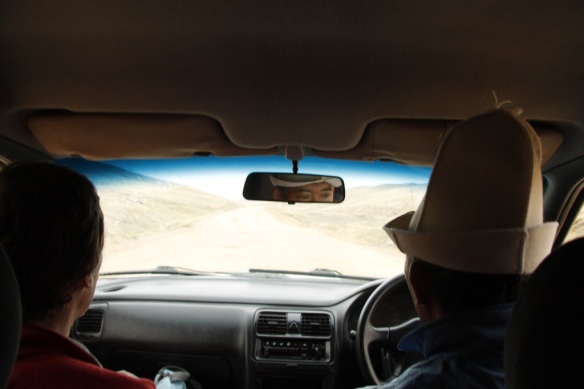
Goodbye to China. Straight away everything felt different. Fewer cars, fewer police, fewer anything. The official time made sense again as we moved our watches back two hours to match the unofficial ‘Xinjiang time’ that was used in western China. The Kyrgyz border post was the perfect picture of Soviet bleakness. Squalid buildings and rooms had to be specially unlocked to allow us to pass through. The cold, the rain, the hats – we couldn’t have felt further away from Kashgar and the Taklaman desert.
A few passport checks later, we were finally out of restricted areas and free to do as we wished. After the intimidating and stifling atmosphere on the Chinese of the border, Kyrgyzstan (quite appropriately) was a proverbial breath of fresh air. Keen to stretch our legs, we asked our driver to take us to the remote Tash Rabat site. This is a large stone building in the middle of nowhere set in high mountain scenery and surrounded by horses, yurts and marmots. No one is quite sure what it is or why it’s here – the theories range from a 15th century Silk Road caravanserai to a 10th century Christian missionary chapel – but either way we thought it was pretty striking and yet more evidence of the centuries of trading that passed through this region from east to west. It was also a handy place for a shack-toilet wee with a view.
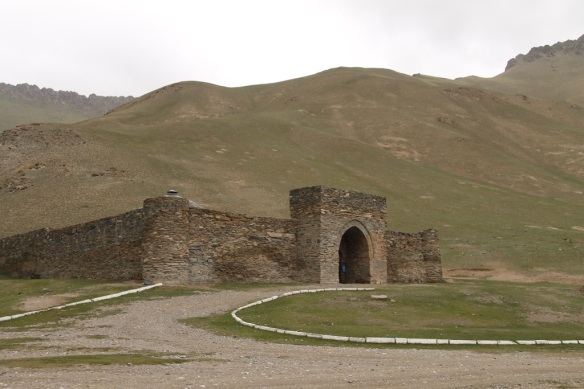
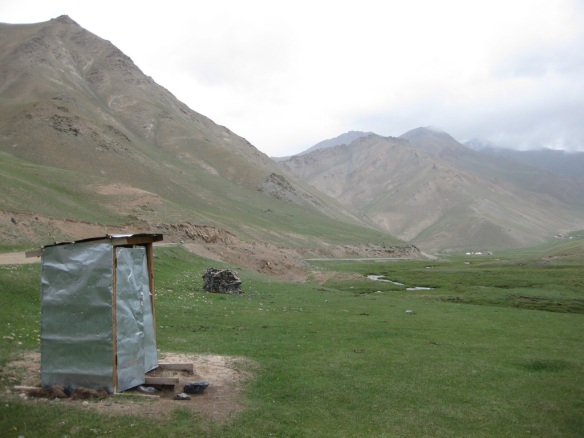
One doesn’t go all the way to Kyrgyzstan to see its towns and cities. Nevertheless, after a full day of driving we had to spend the night in the town of Naryn – one of the largest settlements in Kyrgyzstan. This really isn’t saying much. Nayrn made Bakewell feel like Kuala Lumpur and Midsomer Norton feel like Bangkok. These two shots show Naryn’s high-tech police station and the Soviet-era housing block where we stayed the night.
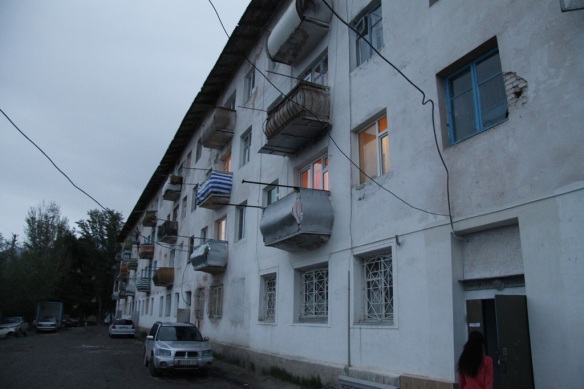
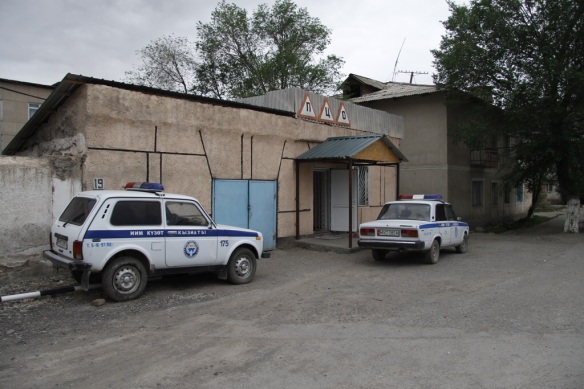
We joined Graham and Carolyn for dinner at one of the only places in town. It was at this point that it hit us all just how culturally different Kyrgyzstan is from China, even though they share a border. The menu was full of Russian and Eastern European staples, the locals were drinking vodka and Baltica beer, and nothing tasted of anything. Knives and forks replaced chopsticks. Black tea replaced green tea. Cheap Russian fake clothing replaced cheap Chinese fake clothing. Heather’s morale sunk as she realised that for the next month of our trip we would be travelling through a culinary wasteland – watery soups, piles of beige carbohydrates, hard bread that smells of mothballs, meat that is barely identifiable as such. The former Soviet Union has a lot to answer for. Oh Penang, how far away you seem now!
The next day we travelled by marshrutka (minibuses that form the backbone of public transport here and in many other former Soviet states) to Kyrgyzstan’s capital city, Bishkek. We travelled through yet more stunning scenery, making several stops at yurt camps to allow passengers to dive out of the marshrutka in order to down pints of fermented mare’s milk, a summer speciality that is all the rage here. Unfortunately this precipitated the emission of noxious gases for the duration of the seven hour trip to Bishkek. Heather, not a dairy-lover at the best of times, became extremely grumpy after James cruelly tricked her into eating a fermented and dried ball of horse yogurt. (James thinks it tastes like really strong goats cheese).
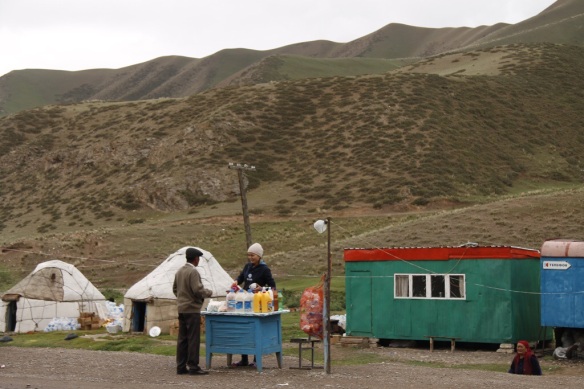
Bishkek was not the metropolis we had expected. Instead, the average street looked something like this:
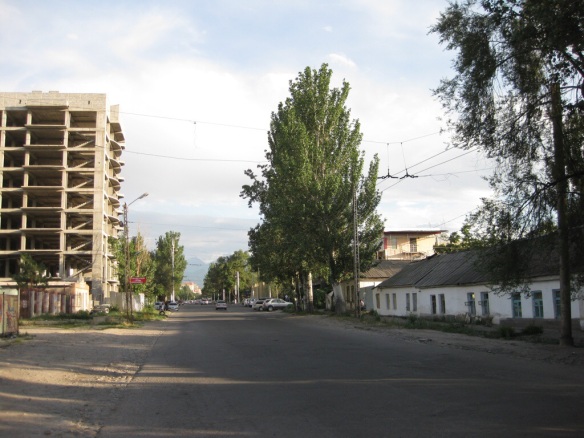
We spent one night here, applied for a Kazakhstan transit visas (the final piece of the visa-puzzle) and then headed for the hills…

